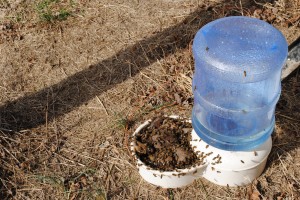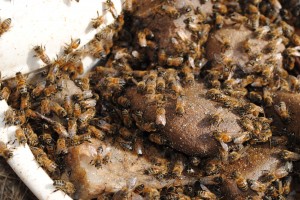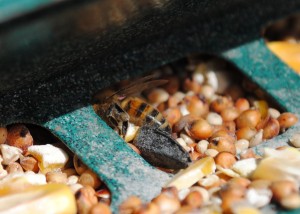Last Spring, there was a lot of consternation about slow build up. Of course, this was only on my part, as the bees went about their business with no worries whatsoever. Basically, both of my hives were building up at about the same pace, but I had spoken to (or emailed) other beekeepers in the area that were seeing more mass (more bees in their hives.)
During one such conversation, back in the Spring of 2010, a beekeeper from Buckingham mentioned that some folks in his neck of the woods would put light syrup on their hives in February to give the hives a jump start. The general theory is that you put a weak sugar-water solution (1 part Sugar to 2 or 3 parts water) on the hives. This makes the bees think that the nectar flow has started and they begin to ‘build up’ (a term that basically means the Queen starts to lay a bunch of eggs). By the time the real nectar flow starts, they will have a TON of bees and really be able to sock away the honey.
Since last Spring, I ran into a wizened beekeeper from yesteryear who put out buckets of syrup water in his apiary to get an early build up. As always, I am fascinated by simple approaches and decided to give it a whirl in one of my outwards.

I mixed up a batch of weak sugar syrup (10 lbs Sugar, 3 Gallons Water) and poured it into one of my old dog waterers. On Sunday, around 11 am, I placed it in a central area between the hives (it was as much as 40 yards from two of the hives and 30 yards from the other three). By late afternoon (right before I went to watch the Steeler’s get a whooping- booyah!), the bees had found it and were on it pretty thick. During lunch today, I checked in on them around noon and they were really putting the stuff down.
It will be interesting to see how this works. I am pretty sure that I never even considered feeding from outside of the hive (now or in the Summer) as I did not want to feed the feral bees. Now, I am having second thoughts. This was very easy and it did not cause any robbing (like it does, on occasion in late Summer, when the syrup is placed within one hive.) I may not ever feed in the Winter again (we’ll see how it goes with this experiment), but I will most definitely feed outside again (until such time as I figure out a good reason not to.)

I actually checked one of the hives and it appeared that they were storing it around the brood nest. I am torn about this behavior. I have a gut feeling (no evidence) that honey from real nectar is much better then my sugar syrup (even if I do have Better Bee in it.) This is the roughest time of the year for a bee, so why give her second rate food (assuming there is a difference between nectar and syrup)? But, on the other hand, it gives me a bit of comfort to know that they are socking away some stores exactly where they’ll need it if (quite honestly, I should say when) it gets cold again (at the edges of the cluster.) But, on the other other hand (is that three hands?), are they filling up cells that the queen might want to lay in? Ha! Who knows. The bees know and that’s all that matters.
Finally, I also put pollen patties on each of the hives in this yard (if brood rearing is going to ramp up, they are going to need some pollen! – well, they may need it if they were lazy last Fall and didn’t put enough away!) This brings me to my last observation for today – protein from the bird feeder! I had heard of it, but had never seen it. Folks have said that bees will sometimes scour bird seed, looking for a few bits of protein in the stray pollen. This past Friday, I found one of my bees (well, a bee in my yard anyway) doing just that! She was running in and out of the feeder, filling her legs up with some dust substance (which was pollen, no doubt – probably not the best, but still worth collecting in her mind.)


Reader Comments
Jones,
I have feed many times openly in 5 gallon buckets in the summer thru fall, check my blog for some pics. I have had no problems and most the big guys do this with 55 gal drums…
One thing to watch is rain, as sometimes the water will sit on top of the syrup and also very cold syrup. Watch for bees sitting and doing nothing for a long time. What can happen is the cold syrup chills them and while they are warming their muscles and stomach back up they run out of daylight and get stranded by the feeder and die. I never had a problem last fall but it never got below freezing like our nights do now… something to watch for as i dont like loosing ANY bee this time of year.
Another note and something i learned this past year was sometimes when feeding and the queen isnt laying heavy (winter, late summer, or letting them make their own queen) they will backfill the brood nest area and go into swarm mode or “decide” the queen isnt laying like they want her too and supercede her. I had this happen on a few of my first splits last spring in April that i let make their own and feed syrup at the same time. They backfilled the brood nest and by the time the queen was ready to lay she had no where to lay so they decided she must be bad and they started supercedure cells…I stopped feeding and cut the cells and everything was ok.
So yes its frustrating finding the right “medium” to feed as all methods have their issues. But i doubt they will ahve enough flying days just yet to backfill too much since the queen isnt laying heavy anyways. So i say keep feeding them, but keep a watchful eye. let us know how it turns out periodically as i am intersted too.
I dont feed syrup at all in the winter, only pollen patties and sugar, but know many who do feed light syrup.So i might give it a try in an open feeder as well… you have got me thinking…especially with the maples i am sure starting to bloom with the warm weather…
Jones,
I enjoy all the information on your website. Since being retired on my central Kentucky farm, I have expanded into honey/bee production. This will be my second year. During my first year, I started four hives and due to the time it took for the brood to build and the drought, I didn’t take any honey. Instead, the bees made it into the winter with two deep brood chambers full.
I plan to start with start next week with pollen patties and some simple syrup to allow the brood chambers to fill before April 1. Then on April 1 (give or take) I want to start adding my supers and stop all feeding. Do you see any problems with this approach? I should say two colonies are together on the same farm. The other two colonies are alone on different farms over 5 miles appart.
@Doug, I have seen that picture before (so, I have read your post on this before) and now am wondering if that fellow up in the mountains told me about buckets or if it was your site! Thanks for the swarm warning. I’ll be vigilant about checking these hives in March. I am sort of hoping to use two of them to start some ‘poor man nuc’s’, so ‘some’ build up would be nice.
@Robert, sounds like you have some good hives. Every approach (and I really do mean every one) has its pitfalls. But I think you’ll do fine with your approach as long as you do not disturb the cluster when it is cool and/or windy and you do not put the syrup in a place where it can drip on your bees when it gets cold.
You’ll want to watch your hive for swarms. It’s not the end of the world if the hives do swarm, but it will reduce your honey take.
I had found a chart last year that showed which plants / trees were ready for the bees to harvest honey from. It also showed the number of bees the average hive would have across an entire year. That link is no longer available and I didn’t download the chart. Do you know of such a chart? It appeared that April and May were prime time for honey production and then in mid June there is a serious decline.
Also, we will be in the mid 50’s this weekend and all next week. That should be a good time for me to get my pollen patties on my hives… I hope.
Best Regards,
Robert
Charts like the one you mentioned are great for generality, but seasons change each year, the chart could be built for say New York and not use etc. Not to mention the lack of certain plants i different areas. The best thing is to visit your hives frequently, walk around the yards and fields morning, lunch, and afternoon and see what your bees are foraging on. Doig this will teach you alot and you will be able to SEE the decline in pollen and nectar about Mid June. You will see you hive change slowely. And remember the bees always are a month ahead of you. They wont produce brood etc if they dont EXPECT pollen to be there a month from then. Thats my thinking anyways.
Kinda like seeing swarm cells, with enough experience and knowing what to look for (backfilling) you can see swarm prepartion well before a swarm cell is produce as they have been preparing for this moment for months. If you see a swarm cell your a month late in changing their minds…
Frequent and through hive inspections are key to learning your seasonal changes. IMO